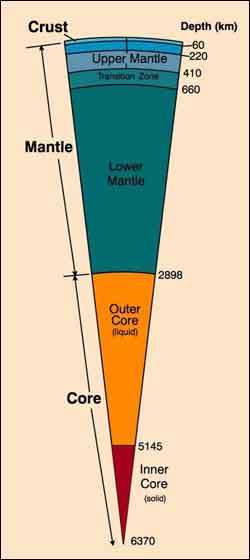Probing the Depths: Hebrew University, Swiss Researchers Analyze the Liquid That Lies Beneath the Surface

Illustration shows the layers of the earth’s subsurface.
While we generally think of water in nature as a cool liquid that we can see — streams, lakes, oceans — there is a great deal of “hot fluid” activity taking place far out of sight, deep within the earth, that influences what ultimately takes place on the surface, including the amount of rainfall and the buildup of new land mass.
What exactly is the nature of that hidden fluid deep beneath the surface and what changes does it undergo as it seeks an ever-deeper venue?
Answer to these questions can be found in article in a recent issue of the journal Nature by Dr. Ronit Kessel of the Hebrew University’s Institute of Earth Sciences and her collaborators Prof. Max Schmidt, Prof. Peter Ulmer and Dr. Thomas Pettke from the Swiss Federal Institute of Technology, Zurich. In the article, the researchers report on a unique study in which fluids released from submerging earth plates at depths of 120-180 kilometers and temperatures between 700 and 1200 degrees centigrade are characterized for the first time.
Although the earth is principally a solid planet, water plays a major role in its evolution and differentiation. The presence of fluid affects the depth, temperature and composition of the melting that takes place deep within the bowels of the earth.
The surface of the earth is broken into large plates which move one relative to the other. When two plates collide, one plate can push the other downwards towards the center, carrying water deep into the mantle, which is the area between the earth’s crust and its core. As water enters the interior of the earth, it passes through water-rich (hydrous) minerals in the rock.
These hydrous minerals break down at depths of 50 to 200 kilometers, facilitating melting and ultimately leading to the super-heated volcanic zone. It is volcanic eruptions which regenerate our continental lithosphere (crust). Such volcanoes created, for example, the Aegean islands in southern Greece (the most famous of them is Santorini, which erupted in the 16th century B.C.E.), the “ring of fire” around the Pacific Ocean, and more.
These volcanoes eject many gases, for example carbon dioxide, to the atmosphere. These gases lead to thickening of the clouds and rain. As a result, water carried down to the interior of the earth influence precipitation on the surface. In addition, water at depth dissolves significant amounts of matter. The mobility of the water at depths also results in recycling other elements (including elements of economic value, such as chromium, nickel and vanadium) from place to place.
In order to characterize the fluids participating in every stage of the downward water cycle, the Hebrew University and Swiss researchers developed a novel experimental and analytical laboratory technique by which the composition of a fluid phase can be directly analyzed following high pressure and temperature experiments. Their work focused on determining how much water is stored in the down-going earth plate, how much dissolved matter it contains, and when these fluids are released from the plate and transferred to the mantle.
The results indicate that up to 180 kilometers deep, two kinds of fluids exist. One, at higher levels, is a fluid rich in water (70-90%) with only a little dissolved matter in it. This fluid exists at relatively low temperatures. The second component is a thick “hydrous melt,” rich in dissolved matter, which contains only 10-30% water. This component is a result of melting of the hydrous rocks at high temperature.
In their studies, the researchers found that different minerals display varying “preferences” for solubility, depending on the temperature at various depth levels.
Beyond a depth of 180 kilometers, only one kind of fluid exists, which is called supercritical liquid. A supercritical liquid is defined as a component which smoothly changes its character from fluid-like to a more solid, melt-like state, but is neither.
The researchers stress that it is essential to distinguish between melts, fluids and supercritical liquids in order to achieve a better understanding of the relationship between the down-going plate and volcanic eruptions and how matter is transferred in the earth interior.
Media Contact
More Information:
http://www.huji.ac.ilAll latest news from the category: Earth Sciences
Earth Sciences (also referred to as Geosciences), which deals with basic issues surrounding our planet, plays a vital role in the area of energy and raw materials supply.
Earth Sciences comprises subjects such as geology, geography, geological informatics, paleontology, mineralogy, petrography, crystallography, geophysics, geodesy, glaciology, cartography, photogrammetry, meteorology and seismology, early-warning systems, earthquake research and polar research.
Newest articles

Scientists transform blood into regenerative materials
… paving the way for personalized, blood-based, 3D-printed implants. Scientists have created a new ‘biocooperative’ material based on blood, which has shown to successfully repair bones, paving the way for…

A new experimental infection model in flies
…offers a fast and cost-effective way to test drugs. Researchers at the Germans Trias i Pujol Research Institute and Hospital have reinforced their leading role in infectious disease research by…

Material developed with novel stretching properties
KIT researchers produce metamaterial with different extension and compression properties than conventional materials. With this material, the working group headed by Professor Martin Wegener at KIT’s Institute of Applied Physics…



